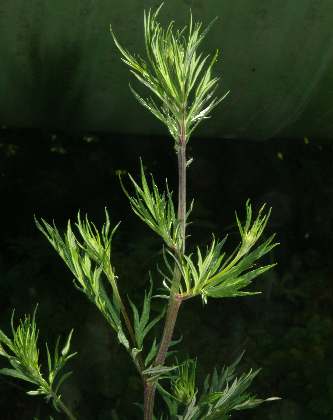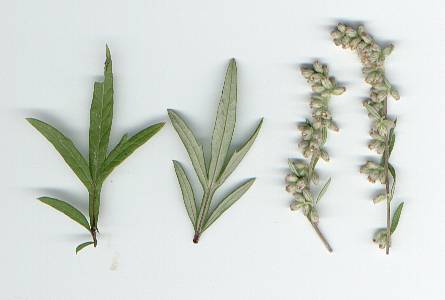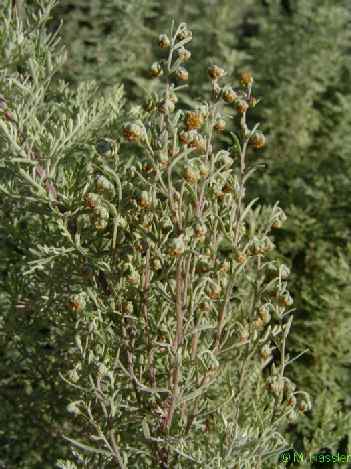The essential oil (0.03 to 0.3%) contains a wealth of different terpenes and
terpene derivatives, e. g., 1,8 cineol, camphor, linalool, thujone,
4-terpineole, borneol, α-cardinol and further mono- and sesquiterpenes.
Quantitative and qualitative composition varies strongly with soil, climate,
fertilizing, and harvest time.
Thujone, one of the oil’s main constituents, is a monoterpenoid ketone also
appearing in sage, thuja and, according to some
sources, in a close relative of mugwort, southernwood.
It is commonly hold responsible for the toxicity of wormwood-flavoured
alcoholics, particularly absinthe,
the drug of the age
in France a hundred years ago (Fin
de siècle). Absinthe was a potent liqueur flavoured with
anise, fennel, plenty of
wormwood and other plants; it was drunk together with water and sugar. The
high alcohol content (often exceeding 60%) and the thujone (typically,
50–100 ppm) both contributed to its psycho-active properties. Since
chronic consume resulted in severe nerve damage, absinthe was banned in nearly
all European countries, with the exception of Portugal and Spain. Liqueurs based
solely on anise (Pernod, Pastis) could establish themselves as alternatives for
absinthe.
Within the European Union, the ban was revoked in 1998, and absinthe has become
legal again, although the thujone content is now restricted to max. 35 ppm.
It is an open question whether the liquor will regain its former popularity.
As wormwood taste intensively bitter, it is almost impossible to incorporate
quantities sufficient for thujone poisoning by accident.
Even if the thujone is separated from the bitter absinthin by distillation,
the resulting product is still too bitter to drink without sugar.
Wormwood-flavoured wine (vermouth) contains only traces of thujone.
Origin
Temperate Europe and Asia.
Etymology
English mugwort
contains an element mu- meaning fly, bug
; cf. Greek
myia [μυία],
Russian mukha [муха]
and German Mücke mosquito
. The Proto-Indo–European stem, MU-, is
obviously onomatopoetic in origin. Folk-etymologically, the first element in
mugwort is often assumed to refer to the herb’s use in beer-brewing
(mug of beer
; see also gale for notes on
brewing).

|
|
Mugwort plant
|
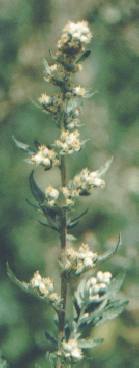
|
|
Mugwort (flower cluster)
|
The second element in mugwort
is an old term for plant
(Old English
wyrt plant
, root
) found in many other Germanic languages: German Wurzel root
(Old High German wurz also had the broader meaning plant
), Swedish
ört, and Gothic waúrts. Less closely related are
Greek rhadamnos [ῥάδαμνος] branch
, Latin radix
root
and Old Irish fren root
, which all derive from a
Proto-Indo–European root WRED. For further etymological connections, see horseradish.
Swedish malört moth plant
for the closely related
wormwood is a similar formation; allegedly, mugwort’s or wormwood’s smell
drives away moths from clothes.
The Modern German name, Beifuß, goes back to Middle
High German bībōʒ and Old High German pīpōʒ;
it is usually derived from an Old High German verb bōʒen beat
,
but the connection is unclear; according to one theory some kind of squeezing the leaves for
food preparation is indicated, according to another, the name refers to some apotropaeic
quality of the plant (it beats or drives away
evil powers).
Already in Middle High German, the plant name bībōʒ got modified towards Fuß foot
by folk etymology, as can be inferred from the parallel form bīvuoʒ.
This probably relates to an ancient belief, reported by Plinius, that mugwort leaves
applied to the feet can make people run longer and faster.
The various Germanic names of the related plant wormwood
(Artemisia absinthium) are not well understood. English
wormwood appears to allude to the vermifuge properties of that plant,
but this is just folk-etymology: The name can be traced back via Old English
vermod to a Common Germanic root wermodaz, which also lies
behind German Wermut (Old High German wermuota). Cf. also the name of a
wormwood-flavoured wine, vermouth. French armoise
amère bitter mugwort
refers to the increased
bitterness of wormwood compared to mugwort.
The botanic species name of wormwood, absinthium, is
indeed the classical Latin name for that plant and derives from Greek
apsinthion [ἀψίνθιον]
(in the New Testament apsinthos [ἄψινθος]);
the word still lives in some Romance tongues: Italian assenzio,
Spanish ajenjo, Galician axenxo and
Portuguese absinto. It has also spread to some unrelated
languages, like Basque axinse and
Hebrew absint [האבסינט].
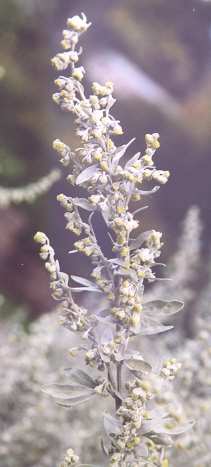
|
|
Wormwood flowers
|
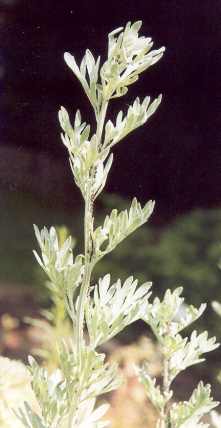
|
|
Sterile wormwood shoot
|
The etymology of Greek apsinthion is not clearly
explained; a theory derives it from a- (negation) +
psinthos [ψίνθος],
an obscure adjective meaning enjoyable
cf. also
Sanskrit ashiva [अशिव] unpleasant, pernicious
.
The meaning of the compound, unpleasant
, would seem fit for a
bitter herb, but may well be the product of folk etymology.
A better guess is that the name actually stems from some Middle Eastern
language: In Middle Persian, the name aspand is recorded for a bitter
plant (perhaps Syrian rue, Peganum harmala); modern Farsi
has afsentin [افسنطین] wormwood
and espand [اسپند] Syrian rue
.
This plant is not related to the herb commonly called rue.
Most Slavonic tongues have similar names for mugwort and its relatives:
Polish piołun, Belarusian palyn [палын],
Slovak palina, Czech pelyňek,
Slovenian and Croatian pelin and also Bulgarian pelin [пелин]
(see below for Russian and Ukrainian cognates). Related names are also found
in other geographically close languages, e. g., Albanian, Romanian and Turkish
pelin, and Lithuanian pelynas. These names are
derived from a Common Slavonic root PAL burn, bright, clear
,
which itself derives from Proto-Indo–European PEL gray
; cf. English
pale (of Romance origin) and the native Germanic fallow, and examples
from classical languages Latin pallidus and Sanskrit pandu [पांडु] pale
.
The semantic connection is not clear: It has been suggested to relate the name
either to the light gray foliage of wormwood or to its burning
bitter taste.
See below for another possible explanation of these names.
Explanation of the pelin-type names if further complicated by the fact
that, although phonetically very similar, these names have in part deviating
denotation: Some of them refer primarily to wormwood (or the related Pontic
or Roman wormwood, Artemisia pontica) and others to mugwort;
yet most have a broader meaning extending to several members of the genus
Artemisia. Even within a language, usage may differ regionally
depending on what species is most abundant locally. To denote a single species
unambiguously, qualifying adjectives are commonly used, e. g., in Russian:
Mugwort polyn obyknovennaya [полынь обыкновенная] common polyn
,
tarragon polyn estragonnaya [полынь эстрагонная] tarragon-polyn
,
southernwood polyn lechebnaya [полынь лечебная] healing polyn
and wormwood polyn gorkaya [полынь горькая] bitter polyn
.
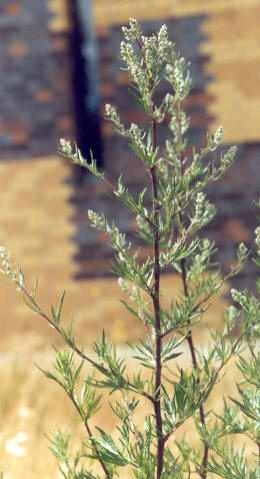
|
|
Mugwort with flowers. Note the black stalks.
|
In some Slavonic languages (of the Western and Eastern branches), mugwort has
another, unrelated name which is said to mean black stalk
or
dark grass
, e. g., Czech černobýl,
Ukrainian chornobyl [чорнобиль],
and Russian chernobyl [чернобыль];
the latter, however, is less commonly used than polyn discussed
above. See nigella for an explanation of the
black
part. In both Russian and in Ukrainian, the same names apply to a
city in Northern Ukraine which became famous due to a disastrous accident in a
nuclear power plant in 1986. This has often been linked to a verse of the
biblical Revelation about the Third Trumpet, when the angel cast a star into
the waters, making them bitter and deadly:
kai to onoma tou asteros legetai ho Apsinthos
[καὶ τὸ ὄνομα τοῦ ἀστέρος λέγεται ὁ Ἄψινθος]
and the name of the star is called wormwood
. Taking the bitter
waters as a metaphor for radioactive pollution, and identifying wormwood
with mugwort, one might then interpret the reactor accident as
predicted by the Bible
.
Actually, wormwood and mugwort, though closely related, are not identical.
Rather correctly, Russian and Ukrainian Bible translations render the Greek
plant name apsinthos not as chernobyl
or chornobyl, but as polyn
(Russian imya sej zvezde polyn [имя сей звезде полынь],
Ukrainian a jmennya sori tij polyn [а ймення зорі тій полин]).
Confused by the inherent ambiguity of that word, some Western journalist have
tried to make a case that the herb mentioned in the Bible is indeed the same
that is called chernobyl, which actually may be true
(for a Russian or Ukrainian Bible translation),
because polyn and chernobyl have indeed
overlapping denotation. This is, however, a good example of a question that
cannot reasonably be answered using a translated text; fortunately, the Greek
original uses an unambiguous term apsinthos that applies only
to wormwood (and maybe other pale-leaved, highly bitter relatives like Pontic
wormwood), but never to mugwort. Yet chernobyl means
mugwort
, nothing else.
Yet there is another connection between mugwort and burning
which might
account for the Slavonic names derived from the root PAL: The Shamanistic
moxa practice (also spelt moksha), which originated in
Central Asia, but is today also part of East Asian medicine. In that
ritual, a Shaman combusts dried herbs for healing purposes. In Chinese
medicine, the method is often employed as following: A thin slice
of ginger is placed on a suitable
acupuncture point, a small portion of the dried
herb is layered on top and slowly combusted. Both the heat and the
constituents of the herb are supposed to contribute to the healing power.
The Japanese term yomogi [蓬, よもぎ]
represents mugwort and related Artemisia species; it can also
be written 艾, but the latter
kanji more often means the moxa method proper (Japanese mogusa [艾, もぐさ]).
Specific names for particular artemisias are usually formed with the
former kanji logograph, e. g.,
niga-yomogi [苦蓬, にがよもぎ] bitter yomogi
(wormwood)
or oo-yomogi [大蓬, おおよもぎ] large yomogi
(A. montana).
Mugwort also has the more specific name
ōshū-yomogi [おうしゅうよもぎ] European yomogi
.
For the derivation of the botanical genus name Artemisia,
see southernwood.
Selected Links
Nature One Health: Mugwort
Alles over Bijvoet (natuurlijkerwijs.com)
About the city Chernobyl (en.wikipedia.org)
Poisonous Plants of North Carolina: Wormwood
Recipe: Japanese Rice Cake (yomogi mochi [蓬餅, よもぎもち]) (the.honoluluadvertiser.com)
More mochi (rice cake) recipes (geocities.com)
Recipe and cultural notes: Bratgans, Weihnachtsgans (German stuffed christmas goose) (ottawa.diplo.de via archive.org)
Rezept: Gefüllte Weihnachtsgans (helmut.friedrichs-essen.de)
